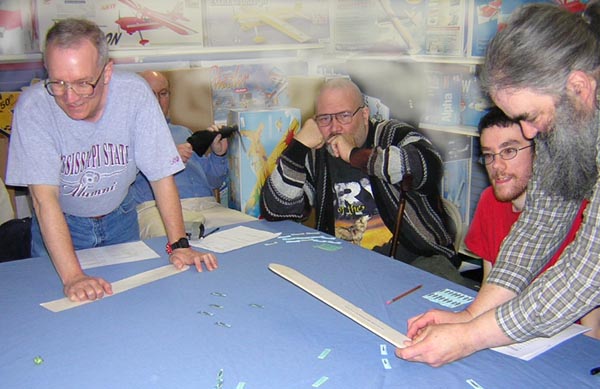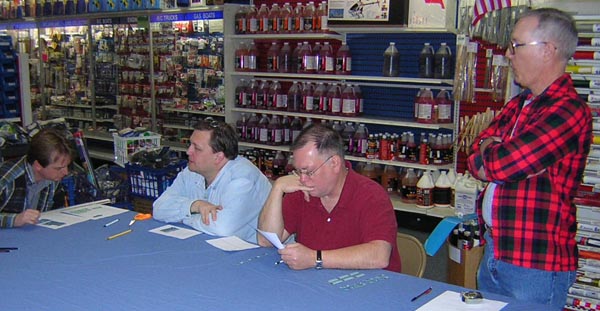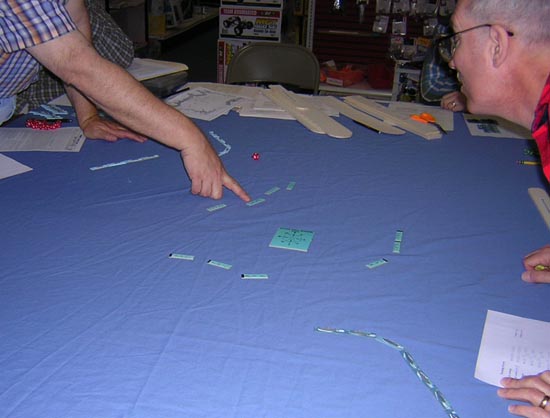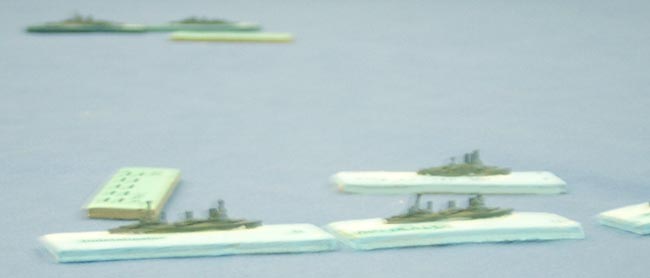

 |
Jackson Gamers' 1/6000 scale WWII Naval Game Action in the North Sea |  |
Jay Stribling ran this WWI naval battle game using Regal Miniatures miniature ships mounted on the counters of the Avalon Hill boardgame Jutland. The German admiral sent his battle cruisers towards the English Channel to cut off and sink the British force of older ships stationed there. The British were soon reinforced by the Battle cruiser force from Rosythe and then the main German force showed up to reinforce his Battle Cruisers.
The Germans were handling the British ships very roughly when, warned by radio intercepts before the Germans even left port, Admiral Jellicoe arrived with the Grand fleet.

Photo by Ed Sansing
Jim Pitts in Gray shirt and Robert Whitfield on the right are operating the high-tech rangefinders (made of Foamcore). Fred Diamond, the British Admiral-in-chief stifles a yawn. Sean Pitts looks on , waiting for his turn to shoot.
Fred Diamond - Flagship, 1st & 2nd Armored Cruiser Sqd, 3rd Battle Cruiser Squadron. Robert Whitfield - The Battle Cruiser Force
5th Battle Squadron, Light forcesSean Pitts - 1st & 2nd Battle Squadron Ed Sansing - Harwich light forces, 3rd Battle Squadron,
3rd Armored Cruiser Squadron

Photo by Ed Sansing
The Game-Master, Jay Stribling, leans forward to try to focus tired old eyes on really small ships. Sean Pitts in red shirt, and Robert Whitfield look on from the left. Travis Melton (German Gross-Admiral) and Tim Latham, in blue shirt, look on from the right.
| Travis Melton - Flagship, 1st & 2nd Battle squadrons, Light forces |
| Tim Latham - 2rd Battle Squadron |
| Mark Stevens - 4th Battle Squadron |
| Jim Pitts - Battle Cruisers |

Photo by Ed Sansing
The German commanders (from the left) Travis Melton, Tim Latham, Mark Stevens and Jim Pitts confer. Travis was the German commander. He and Mark seem to be confused by the organization of the tiny ship.
These 1/6000 ships are a bit tiny for those of us who are used to 28mm soldiers!

Photo by Ed Sansing
The British Grand fleet, in four columns, steams into the battle area.

Photo by Ed Sansing
The Game-master, Jay Stribling, points out which destroyer counters were German and which were British. Jim Pitts peers at the finger. If we play with ships this small in the future, we need more light. Age 50+ eyes need all the help that they can get! Perhaps the commanders should bring binoculars?
Was this a historical replay of the battle of Jutland?
No - not even close. Jay Stribling in his maniacal purchasing of those tiny 1/6000 ships has added ships that were sunk before the battle - the British dreadnought Audacious for example, and the armored cruisers, Aboukir, Cressy and Hogue. Ships such as the Queen Elizabeth which was in the Mediteranian Sea at the time, and the Emperor of India which was in dock are in his battle fleet.
The Germans benefitted from ships such as the Hindenberg and the Baden which were not yet completed in 1916.

Photo by Ed Sansing
The German Battle cruiser force steams towards the left. The Regal miniatures are small enought that they fit exactly onto the Jutland game counters. A bit of white paint produces a bow wave and a wake at the stern. The German ship counters are painted just a bit darker and grayer blue than the British. That really helps to tell them apart.

Photo by Ed Sansing
A blurry close-up which shows the ships at very close to real size. The counters are about 2.24 inches long, and .5 inches wide. Most of the battleships are about 1.75 inches in length. We use the destroyer counters and Light Cruiser counters from the game without adding any miniature ships to them.
What rules did you use?
We used the Advanced Jutland rules - right out of the box. The main changes were twofold. First a "home rule" that required all squadron commanders to roll a D10 at the start of each turn. If a "10" was the result, they could concentrate the fire of the ships in thier squadron as they saw fit. If any other result was obtained, each ship was required to fire at it's opposite number in the enemy formation so far as possible. The game master arbitrated this.
Secondly, we changed all charts and tables so as to use D10 dice instead of D6 dice. This allowed critical hits only on a result of "10" instead of "6" as in the original charts and tables.
Also, Jay Stribling cut and pasted the damage record sheets so that each player had only the ships in his squadron on his hit record pad, instead of all the ships in his country's fleet.

Photo by Ed Sansing
The Blue arrow shows the direction of the British Battle Cruiser force. The red arrow shows the German Battle cruisers and thier direction. One of the British ships has blown up - note the cotton puff.

Photo by Ed Sansing
The same action as in the image above, but from a different angle.
GERMAN LOSSES
9 Light Cruisers, 1 battleship, 2 battle cruisers
BRITISH LOSSES
21 Light Cruisers, 10 capitol ships (mainly Battle cruisers)
SO - Who won the game?
At the end of the game, the British had 9 victory points, to the Germans' 30.5 points. So the Germans won the game overwhelmingly. However, to the German's horror, the British players found that they had accidentally left thier two strongest battle squadrons back at Scapa Flow. Or was this a trick by that sneaky British admiral Jellico.
In our next game both sides will have completed some repairs to damaged ships, but none of the sunken ones will be raised! And the British will bring ALL of their ships this time! And if neccesary for a third game, Jay Stribling might find it neccesary to purchase American dreadnoughts! Ha ha - no taint of fairness will be allowed in the continuing great North sea battleship shootout!
Return to the Master Index of Photos and Games
Return to the Jackson Gamers' Homepage
Angelfire - Free Home Pages
Free Web Building Help
Angelfire HTML Library
htmlGEAR - free polls, guestbooks, and more!
Thank you for visiting The Jackson Gamers' pages at Angelfire. Please come back and visit again!